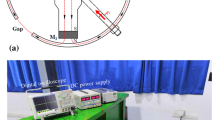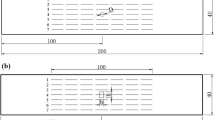Abstract
The casing damage has been a big problem in oilfield production. The current detection methods mostly are used after casing damage, which is not very effective. With the rapid development of China’s offshore oil industry, the number of offshore oil wells is becoming larger and larger. Because the cost of offshore oil well is very high, the casing damage will cause huge economic losses. What’s more, it can also bring serious pollution to marine environment. So the effective methods of detecting casing damage are required badly. The accumulation of stress is the main reason for the casing damage. Magnetic anisotropy technique based on counter magnetostriction effect can detect the stress of casing in real time and help us to find out the hidden dangers in time. It is essential for us to prevent the casing damage from occurring. However, such technique is still in the development stage. Previous studies mostly got the relationship between stress and magnetic signals by physical experiment, and the study of physical mechanism in relative magnetic permeability connecting the stress and magnetic signals is rarely reported. The present paper uses the ANSYS to do the three-dimensional finite element numerical simulation to study how the relative magnetic permeability works for the oil casing model. We find that the quantitative relationship between the stress’s variation and magnetic induction intensity’s variation is: Δδ = K* ΔB, K = 8.04×109, which is proved correct by physical experiment.
Similar content being viewed by others
References
Auslender, M., Liverts, E., Zadov, B., Elmalem, A., Zhdanov, A., Grosz, A., and Paperno, E., 2013. Inverse effect of magnetostriction in magnetoelectric laminates. Applied Physics Letters, 103: 022907, DOI: 10.1063/1.4812483.
Baudendistel, T. A., and Turner, M. L., 2007. A novel inverse-magnetostrictive force sensor. IEEE Sensors Journal, 7(2): 245–250.
Bechtold, C., Teliban, I., Thede, C., Chemnitz, S., and Quandt, E., 2010. Non-contact strain measurements based on inverse magnetostriction. Sensors and Actuators A: Physical, 158(2): 224–230.
Ekreem, N. B., Olabi, A. G., Prescott, T., Rafferty, A., and Hashmi, M. S. J., 2007. An overview of magnetostriction, its use and methods to measure these properties. Journal of Materials Processing Technology, 191(1–3): 96–101.
Evangelos, H., and Aphrodite, K., 2007. Magnetostriction and magnetostrictive materials for sensing applications. Journal of Magnetism and Magnetic Materials, 316: 372–378.
Jiang, B. J., 2006. The state of arts and trend of magnetic detecting technique. Nondestructive Testing, 28(7): 362–366.
Karl, W. J., Powell, A. L., Watts, R., Gibbs, M. R. J., and Whitehouse, C. R., 2000. A micro machined magneto strictive pressure sensor using magneto-optical interrogation. Sensors & Actuators: A. Physical, 81(1): 137–141.
Laguerre, L., Aime, J. C., and Brissaud, M., 2002. Magnetostrictive pulse echoed vice for non destructive evaluation of cylindrical steel materials using longitudinal guided waves. Ultrasonics, 152–155.
Liu, Q. X., 2006. The Casing Condition Logging and the Study of the Method to Detect the Casing Stress. China University of Geosciences, Beijing, 14–77.
Mohammed, O. A., Liu, S., and Abed, N., 2004. Study of the inverse magnetostriction effect on machine deformation. IEEE Southeast Con, Proceedings, 433–436.
Olabi, A. G., and Grunwald, A., 2008. Design and application of magnetostrictive materials. Materials and Design, 29: 469–483.
Pulnikov, A., Permiakov, V., and De Wulf, M., 2003. Measuring setup for the investigation of the influence of mechanical stresses on magnetic properties of electrical steel. Journal of Magnetism and Magnetic Materials, 254: 47–49.
Pulnikov, A., Permiakov, V., Petrov, R., Gyselinck, J., Langelaan, G., Wisselink, H., Dupre, L., Houbaert, Y., and Melkebeek, J., 2004. Investigation of residual stresses by means of local magnetic measurement. Journal of Magnetism and Magnetic Materials, 272–276: 2303–2304.
Rafferty, A., Bakir, S., Brabazon, D., and Prescott, T., 2009. Calibration and characterisation with a new laser-based magnetostriction measurement system. Materials and Design, 30: 1680–1684.
Sakai, Y., and Unishi, H., 2004. Non-destructive method for bending stress evaluation of linepipes using a magnetic anisotropy sensor. Journal of the Japanese Society for Non-Destructive Inspection, 53(12): 767–777.
Sun, Z. Y., 2011. Stress Detecting Technology Research of Construction Steel Materials Based on Magnetic Coupling. Institute of Engineering Mechanics, China Earthquake Administration, 4–28.
Tian, M. B., 2001. Magnetic Materials. Tsinghua University Press, Beijing, 11–45.
Wang, S. L., Wang, W., Su, S. Q., and Zhang, S. F., 2005. Amagneto-mechanical model on differential permeability and stress of ferromagnetic material. Journal of Xi’an University of Science & Technology, 25(3): 288–305.
Wang, Y. M., Kang, Y. H., and Wu, X. J., 2005. Magnetostrictive effect and its application to NDT. Journal of Huazhong University of Science and Technology (Nature Science Edition), 33(1): 75–77.
Wang, Z. Y., Ma, W. Z., Zhou, Z. B., Li, Z. P., and Qi, X. Y., 2007. Study and application of casing stress measuring tool. Well Logging Technology, 31(2): 163–165.
Wang, Z. Y., Li, Z. P., Yang, X. B., Ma, W. Z., Zhou, Z. B., and Qi, X. Y., 2012. Study on interpretation method of magnetism-stress Log data. Well Logging Technology, 36(1): 51–55.
Xiong, E. G., Wang, S. L., Zhao, J. H., Gao, Z. H., and Li, B., 2011. A theoretical and experimental study on the dependency relationship of magnetic flux versus stress for steel. Journal of Harbin Engineering University, 32(3): 294–297.
Xu, Y., 2011. Study on stress detection method based on magneto elastic effect. National Defense Science and Technology University, Changsha, 1–33.
Yang, X., Liu, S. H., Li, F., Zhang, S. M., and Wang, W. M., 2013. Research progress in casing detection technology. China Petroleum Machinery, 41(8): 17–21.
Żurek, Z. H., 2005. Magnetic contactless detection of stress distribution and assembly defects in constructional steel element. NDT & E International, 38(7): 589–595.
Author information
Authors and Affiliations
Corresponding author
Rights and permissions
About this article
Cite this article
Meng, F., Zhang, J., Yang, C. et al. Three-dimensional finite element numerical simulation and physical experiment for magnetism-stress detecting in oil casing. J. Ocean Univ. China 14, 669–674 (2015). https://doi.org/10.1007/s11802-015-2669-y
Received:
Revised:
Accepted:
Published:
Issue Date:
DOI: https://doi.org/10.1007/s11802-015-2669-y




